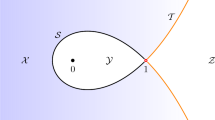Abstract
We show that a direct numerical computation of the coefficients of any method based on the exponential fitting is possible. This makes unnecessary the knowledge of long sets of analytical expressions for the coefficients, as usually presented in the literature. Consequently, the task of any potential user for writing his/her own code becomes much simpler. The approach is illustrated on the case of the Numerov method for the Schrödinger equation, on a version for which the analytic expressions of coefficients are not known.

Similar content being viewed by others
References
Ixaru, L.Gr., Vanden Berghe, G.: Exponential Fitting. Kluwer Academic Publishers, Dordrecht/Boston/London (2004)
Paternoster, B.: Present state-of-the-art in exponential fitting. A contribution dedicated to Liviu Ixaru on his 70-th anniversary. Comput. Phys. Commun. 183, 2499–2512 (2012)
Calvo, M., Franco, J.M., Montijano, J.I., Randez, L.: Explicit Runge-Kutta methods for initial value problems with oscillating solutions. J. Comput. Appl. Math. 76, 195–212 (1996)
Dai, Y., Wang, Z., Wu, D.: A four-step trigonometric fitted P-stable Obrechkoff method for periodic initial-value problems. J. Comput. Appl. Math. 187, 192–201 (2006)
Franco, J.M.: Exponentially fitted symplectic integrators of RKN type for solving oscillatory problems. Comput. Phys. Commun. 177, 479–492 (2007)
Kim, K.J., Cools, R.: Extended exponentially fitted interpolation formulas for oscillatory functions. Appl. Math. Comput. 224, 178–195 (2013). https://doi.org/10.1016/j.amc.2013.08.039
Conte, D., Paternoster, B.: Modified Gauss–Laguerre exponential fitting based formulae. J. Sci. Comput. 69, 227–243 (2016). https://rd.springer.com/journal/10915
Cardone, A., D’Ambrosio, R., Paternoster, B.: Exponentially fitted IMEX methods for advection–diffusion problems. J. Comput. Appl. Math. 316, 100–108 (2017)
Ngwane, F.F., Jator, S.N.: A trigonometrically fitted block method for solving oscillatory second-order initial value problems and hamiltonian systems. International Journal of Differential Equations Article ID 9293530. https://doi.org/10.1155/2017/9293530 (2017)
D’Ambrosio, R., Moccaldi, M., Paternoster, B.: Adapted numerical methods for advection-reaction-diffusion problems generating periodic wavefronts. Comput. Math. Appl. 74, 1029–1042 (2017)
Cardone, A., D’Ambrosio, R., Paternoster, B.: High order exponentially fitted methods for Volterra integral equations with periodic solution. Appl. Num. Math. 114, 18–29 (2017). http://www.sciencedirect.com/science/journal/01689274
Medvedev, M.A., Simos, T.E., Tsitouras, C.: Fitted modifications of Runge-Kutta pairs of orders 6(5). Math Meth. Appl. Sci. 41, 6184–6194 (2018). https://doi.org/10.1002/mma.5128
Franco, J.M., Randez, L.: A class of explicit high-order exponentially-fitted two-step methods for solving oscillatory IVPs. J. Comput. Appl. Math. 342, 210–224 (2018)
Fang, Y., Yang, Y., You, X.: Fitted two-step hybrid methods for the resonant state of the Schrodinger equation. Int. J. Mod. Phys. C 29Art. No 1850055 (2018)
Zahra, W.K., Nasr, M.A., Van Daele, M.: Exponentially fitted methods for solving time fractional nonlinear reaction-diffusion equation. Appl. Math. Comput. 358, 468–490 (2019)
Xu, M., Simos, T.E.: A multistage two-step fraught in phase scheme for problems in mathematical chemistry. J. Math. Chem. 57, 1710–1731 (2019). https://doi.org/10.1007/s10910-019-01033-0
Zhao, Z., Luo, J., Lin, C.-L., Simos, T.E.: Full in phase finite difference algorithm for differential equations in quantum chemistry. J. Math. Chem. 58, 1197–1218 (2020). https://doi.org/10.1007/s10910-020-01125-2
Ixaru, L.Gr.: Exponential and trigonometrical fittings: user-friendly expressions for the coefficients, vol. 82 (2019)
Ixaru, L.Gr.: Operations on oscillatory functions. Comput. Phys. Commun. 105, 1–19 (1997)
Ixaru, L.Gr., De Meyer, H., Vanden Berghe, G., Van Daele, M.: A regularization procedure for \({\sum }_{i=1}^{n} f_{i}(z_{j})x_{i}=g(z_{j}); (j = 1, 2,\cdots , n)\). J. of Linear Algebra 3, 81–90 (1996)
Ixaru, L.Gr.: Numerical Methods for Differential Equations and Applications. Reidel, Dordrecht-Boston-Lancaster (1984)
Child, M.S., Chambers, A.V.: Persistent accidental degeneracies for the Coffey-Evans potential. J. Phys. Chem. 92, 3122–3124 (1988)
Marletta, M.: Certification of algorithm 700 numerical tests of the SLEIGN software for Sturm-Liouville problems. ACM Trans. Math. Softw. 17, 481–490 (1991)
Conte, D., Esposito, E., Paternoster, B., Ixaru, L.Gr.: Some new uses of the ηm(z) functions. Comput. Phys. Commun. 181, 128–137 (2010)
Acknowledgments
This research was supported in the frame of contract PN 18090101/ 2018 with the Romanian Ministry of Research and Innovation.
Author information
Authors and Affiliations
Corresponding author
Additional information
Publisher’s note
Springer Nature remains neutral with regard to jurisdictional claims in published maps and institutional affiliations.
Appendix
Appendix
Eta functions η− 1(Z),η0(Z),η1(Z),... are defined as follows [1, 19, 21]:
The first two are
In some papers, function η− 1(Z) is denoted ξ(Z).
Functions ηm(Z) with m > 0 are generated by recurrence
if Z≠ 0, and by following values at Z = 0 :
Some useful properties are:
Series expansion:
Asymptotic behavior at large |Z| :
Differentiation properties:
The latter is important in subroutine REGSOLV for solving (3) because there the expressions of the derivatives of functions Fn(Z),n = 1,2,⋯ ,N and B(Z) are also requested.
The expressions needed in system (4) for these functions and their derivatives are:
Codes for the computation of the eta functions are available: subroutines GEBASE and GEBASEV (fortran 95, double precision arithmetic) in the compact disk attached to book [1]; see also formConv (mathematica) in [24].
For solving (4), we have used derivatives up to mmax = 30 with eta functions computed by GEBASEV.
Rights and permissions
About this article
Cite this article
Ixaru, L.G. Numerical computation of the coefficients in exponential fitting. Numer Algor 87, 1097–1106 (2021). https://doi.org/10.1007/s11075-020-01000-w
Received:
Accepted:
Published:
Issue Date:
DOI: https://doi.org/10.1007/s11075-020-01000-w



